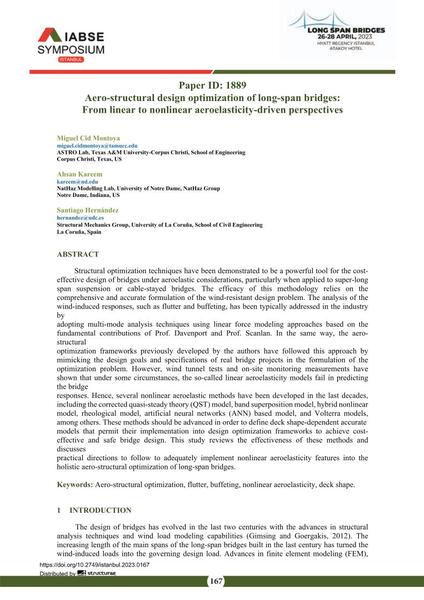Aero-structural design optimization of long-span bridges: From linear to nonlinear aeroelasticity-driven perspectives

|
|
|||||||||||
Bibliographic Details
| Author(s): |
Miguel Cid Montoya
(ASTRO Lab, Texas A&M University-Corpus Christi, School of Engineering Corpus Christi, Texas, US)
Ahsan Kareem (NatHaz Modelling Lab, University of Notre Dame, NatHaz Group Notre Dame, Indiana, US) Santiago Hernández (Structural Mechanics Group, University of La Coruña, School of Civil Engineering La Coruña, Spain) |
||||
|---|---|---|---|---|---|
| Medium: | conference paper | ||||
| Language(s): | English | ||||
| Conference: | IABSE Symposium: Long Span Bridges, Istanbul, Turkey, 26-28 April 2023 | ||||
| Published in: | IABSE Symposium Istanbul 2023 | ||||
|
|||||
| Page(s): | 167-174 | ||||
| Total no. of pages: | 8 | ||||
| Year: | 2023 | ||||
| DOI: | 10.2749/istanbul.2023.0167 | ||||
| Abstract: |
Structural optimization techniques have been demonstrated to be a powerful tool for the cost-effective design of bridges under aeroelastic considerations, particularly when applied to super-long span suspension or cable-stayed bridges. The efficacy of this methodology relies on the comprehensive and accurate formulation of the wind-resistant design problem. The analysis of the wind-induced responses, such as flutter and buffeting, has been typically addressed in the industry by adopting multi-mode analysis techniques using linear force modeling approaches based on the fundamental contributions of Prof. Davenport and Prof. Scanlan. In the same way, the aero-structural optimization frameworks previously developed by the authors have followed this approach by mimicking the design goals and specifications of real bridge projects in the formulation of the optimization problem. However, wind tunnel tests and on-site monitoring measurements have shown that under some circumstances, the so-called linear aeroelasticity models fail in predicting the bridge responses. Hence, several nonlinear aeroelastic methods have been developed in the last decades, including the corrected quasi-steady theory (QST) model, band superposition model, hybrid nonlinear model, rheological model, artificial neural networks (ANN) based model, and Volterra models, among others. These methods should be advanced in order to define deck shape-dependent accurate models that permit their implementation into design optimization frameworks to achieve cost-effective and safe bridge design. This study reviews the effectiveness of these methods and discusses practical directions to follow to adequately implement nonlinear aeroelasticity features into the holistic aero-structural optimization of long-span bridges. |
||||
| Keywords: |
flutter buffeting Aero-structural optimization nonlinear aeroelasticity deck shape
|
||||
